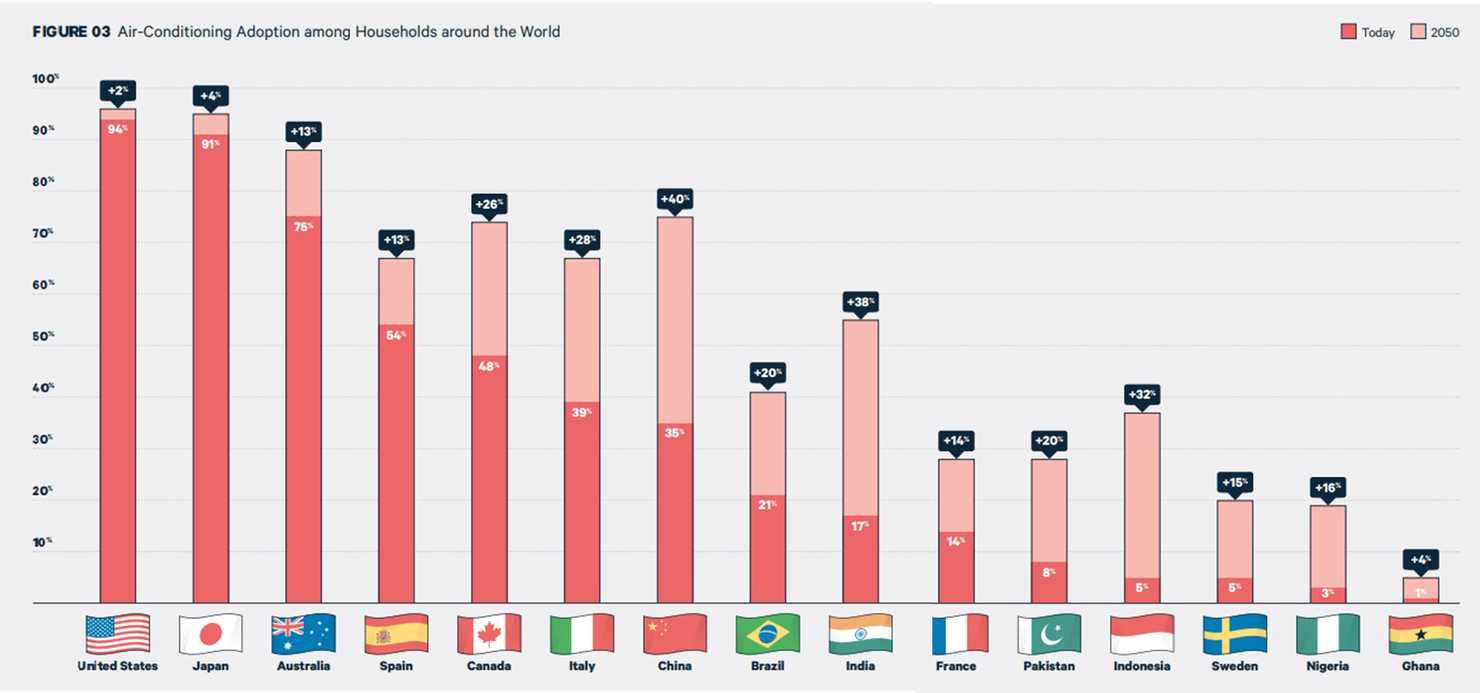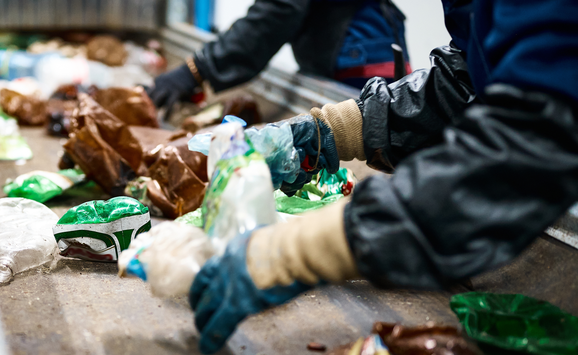Deadly heat waves, which currently endanger the health and survival of three-quarters of the world population, cannot be called “extreme” events, because they are not rare anymore.
After heat waves in 2023 and 2024 proved deadly in India and Mexico, more than 1,300 people died in Saudi Arabia during this year’s Hajj pilgrimage because of extremely high temperatures at Islamic holy sites. Most of those deaths were unregistered pilgrims who were not authorized to shelter during the heat wave in tents equipped with air-conditioning (AC).

75% humidity, 25°C. A family catches shade from a beached boat in Sicily.
In the next few decades, large parts of the global population will continue to adapt to rising temperatures by increasing their demand for cooling energy. Without drastic improvements in energy efficiency and in the use of low-carbon energy sources, the additional energy demand driven by AC will make efforts to reduce greenhouse gas emissions more difficult and costly. Humanity, therefore, faces the risk of being trapped in a new, vicious cycle created by individual behaviors at the aggregate scale and urban environments that are shaped by the ubiquity of AC.
Today, not only has AC triumphed as the predominant cooling strategy, but AC also has displaced myriad other environmentally friendly cooling strategies and building practices based on principles that have been used throughout history, especially in hot countries.

Left: Amer Fort in Jaipur, build in 967 CE with passive cooling principles.
Right: A family rides a scooter in the Kemayoran district of Jakarta.
The Cooling Solution is a scientific and photographic project which examines the rush of almost every household on the planet to buy an air conditioner as soon as they can afford its high running costs. A rare combination of scientific results, visual approaches, and storytelling, The Cooling Solution has been on exhibit in Venice in 2023 and in New York City and London in 2024. Through our research and the stories we include in the project, we document cases of ineffective and inefficient cooling; hypercooling; heat dumping; vernacular architecture; and cutting-edge cooling technologies in Brazil, India, Indonesia, Italy, and the United States. We show how people adapt to conditions of high temperature and humidity across geographies, cultures, and socioeconomic conditions in very different societies.
Populous, tropical countries with booming economies are central to the study, because those are the places where AC use will increase dramatically in the next 30 years (Figure 1). Italy was chosen as a Western counterpart where increases in AC use are linked to the warming climate rather than economic growth.
Figure 1. Air-Conditioner Adoption by Country and Income Group

In the title of the project, the term “solution” is meant to call this adaptation paradigm into question. In the past several decades, AC has become established as a ubiquitous and intensely advertised strategy to cope with extreme heat across the globe. In a world that tends to get canalized on a few dominant technologies such as mechanical cooling, individuals acting independently—but at the aggregate scale of millions of people—produce global consequences. For instance, the precipitous growth in AC use creates a buildup of huge amounts of energy demand and the release of greenhouse gas emissions. These massive and complex impacts can go unnoticed, together with the increased discomfort of millions of people who still cannot afford AC.
The world population was under 2 billion in 1902 when the first AC was invented. Today, megacities are coming to terms with heat waves and are installing this century-old technology at an unprecedented rate. According to the International Energy Agency, 10 new AC units will be sold every second in the next 30 years, bringing the number of installed units to 5.6 billion worldwide by the year 2050. Our research shows that the widespread use of AC will save lives, but could account for up to 7 percent of the cumulative greenhouse gas emissions between now and 2100.
The Future of Air-Conditioning
Since modern record keeping began in 1880, temperatures around the globe have been exceeding previous highs, year after year. Prolonged exposure to high temperatures and high humidity levels can have severe effects on human health, and heat stress is approaching critical thresholds in many regions.
Figure 2. Number of Days per Year with a Heat Index above 32°C (89.6°F)

In the next 30 years, the number of days per year with a heat index above 32°C (89.6°F) will increase in all the countries we analyzed, especially Indonesia (Figure 2). Heat index measures what the temperature feels like to the human body when air temperature is combined with relative humidity. For instance, when the ambient air has a temperature of 30°C (86°F) and 80 percent relative humidity, the heat index is 37.7°C (99.9°F).
Thermal comfort also depends on thermal sensitivity and personal attributes. Elderly people with preexisting health conditions have a lower capacity to thermoregulate. Today, only 4 percent of the global population aged 69 and above inhabit a climate in which the hottest days throughout the year exceed the critical threshold of 37.5°C (99.5°F). By 2050, more than 23 percent of elderly people will live in these excessively hot conditions, exposing an additional 177 million–246 million older adults to dangerous acute heat. The effects will be most severe in Asia and Africa, countries that also have the lowest adaptive capacity.

Left: 77% humidity, 26°C. The Mumbai skyline behind a street in the fishing village of Worli.
Right: 55% humidity, 24°C. Lawn maintenance at an 18th-century observatory in Jaipur.
To cope, or simply to seek comfort, people around the world decide among a variety of cooling strategies based on their income, cultural background, and climate. The most popular solution, as soon as one can afford it, is usually AC.
While the United States and Japan are at the top of the charts for AC use, Europeans historically have been less inclined to employ the mechanical solution. Within the next three decades, the vast middle class of many tropical, populous, growing countries will expand and acquire billions more AC units for heat relief (Figure 3).
Figure 3. Air-Conditioning Adoption among Households around the World

Historically, the United States, Japan, and Australia have led the globe in terms of AC adoption. In the next three decades, a major shift toward widespread use of air-conditioning will happen in tropical, populous, growing countries such as India.
Vulnerability to Heat
The sources of vulnerability and the implications of rising heat vary across countries. Heat waves, which are escalating in frequency, duration, and intensity, have prompted governments worldwide to issue vital health warnings as attempts to protect populations. These warnings include urging individuals to stay cool, stay hydrated, avoid direct sun exposure, and minimize strenuous activities.

45% humidity, 32°C. Professional dancer Akos Barat cools down with his dogs in Milan.
Regrettably, a significant segment of the population faces substantial challenges in responding to these crucial recommendations due to a range of issues, termed “systemic cooling poverty.” Systemic cooling poverty encompasses intricate layers of physical, social, and intangible deficiencies of infrastructure, impeding the provision of essential services that are necessary to ensure thermal safety during extreme heat episodes.
Vulnerabilities also are related to the intersection of cumulative disadvantages, such as gender, disability, ethnicity, sexual orientation, age, and health status.
How to Keep Cool without Overheating the Earth
Over the past 100 years, the rise of AC as a leading cooling strategy was determined largely by residential architecture that complied with a thirst for cheap, rapid growth in modern cities and the isolation of apartment units, which created the need for mechanical ventilation.
AC has displaced alternative cooling strategies and building practices that have been used throughout history, especially in hot countries.
Architects and scientists across the world now are combining cutting-edge technologies with principles of traditional architecture, including shading, wise building orientation, and evaporative and passive cooling.

77% humidity, 28°C. An air-conditioning unit for every room in a Mumbai building.
For instance, the Museum of Tomorrow is a science museum in Rio de Janeiro, Brazil, designed by Spanish neofuturistic architect Santiago Calatrava in 2015. Built next to the waterfront at Pier Mauá, the museum’s AC system uses seawater associated with plate heat exchangers for heat rejection. The temperature of the seawater in Rio de Janeiro declines to lower values during the summer due to sea currents, reaching temperatures close to 20°C (68°F), much lower than the summer ambient air temperatures of 26–38°C (78.8–100.4°F) or of local freshwater resources around 29–30°C (84.2–86°F), which normally are used in traditional cooling towers. This pioneering feature allows for highly energy-efficient operation while eliminating freshwater consumption in cooling towers. In addition, the museum’s ventilated air passes through a dedicated system that contains a device called an enthalpy wheel, which recovers heat energy from the air for other productive uses, and a desiccant wheel, which dehumidifies the air—both of which are important for ensuring controlled climate conditions indoors, especially in the hot and humid tropical climate of Brazil.
As strategies to mitigate greenhouse gas emissions become more ambitious in countries across the world, adaptation might represent a final opportunity to elevate carbon-free technologies and energy services to the mainstream.

67% humidity, 25°C. The upper-middle class neighborhood of Flamengo in Rio de Janeiro.
To take another example from Rio de Janeiro, the lack of access to affordable, reliable, and sustainable energy in low-income communities is a major issue in the city’s informal urban settlements. The nonprofit organization Revolusolar provides distributed solar energy to low-income communities in Rio, making people the protagonists of the process. Revolusolar provides solar installations through a rental model, professional training, children’s workshops on sustainability and energy, and related research. The organization already has installed three photovoltaic systems in Rio, which generate about 15,600 kilowatt-hours per year and save R$15,000 in energy expenses annually. Revolusolar plans to create the first cooperative for distributed energy generation in the favela of Babilônia in Rio, with the organization providing coordination, fundraising, contracting, administrative support, and ongoing maintenance for the photovoltaic generator.

Left: 34% humidity, 35°C. Patrizia De Rossi checks solar radiation sensors near Rome.
Right: 59% humidity, 30°C. Beachgoers seek relief from the heat in the waters of Sicily.
The next few years will be crucial to avoid becoming trapped in carbon-intensive habits that exacerbate the climate crisis. Alternatives to high-emitting systems exist, but these options currently are confined to rare and small-scale cases. A cultural shift would help in avoiding an immediate reliance on AC when equally effective options could work. Additional large-scale transformation could be facilitated by regulations in the building sector, which could retrofit buildings with features that help with space cooling, so that residents do not have to rely on AC. We need a systematic approach to cooling that goes beyond the mere ability to use mechanical cooling in buildings. A cooling solution could involve leveraging the natural characteristics of the surrounding environment, such as preserving green and blue areas, as well as individual, often socially-constructed, habits.
Resources for the Future (RFF) has partnered with Italy’s Euro-Mediterranean Center on Climate Change (CMCC) to create the RFF-CMCC European Institute on Economics and the Environment (EIEE).
All photos above by Gaia Squarci.









